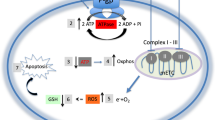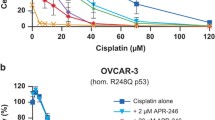Summary
We evaluated the multidrug resistance (MDR)-modulating effects of progesterone (PRG) and an orally active, structurally related compound, megestrol acetate (MA), in several MDR human cell lines. At 100 μm, both steroids inhibited the binding of aVinca alkaloid photoaffinity analog to P-glycoprotein (P-gp) in MDR human neuroblastic SH-SY5Y/VCR cells [which show >1500-fold resistance to vincristine (VCR) in the tetrazolium dye (MTT) assay]. However, 100 μm MA markedly enhanced the binding of [3H]-azidopine to P-gp in both SH-SY5Y/VCR cells and the MDR human epidermoid KB-GSV2 cell line (which displays 250-fold resistance to VCR in the MTT assay). PRG had little effect on the binding of [3H]-azidopine to P-gp. MA at low doses was more effective than PRG in sensitizing cells to VCR and enhancing their accumulation of [3H]-VCR. The highly resistant SH-SY5Y/VCR subline exhibited significant collateral sensitivity to both steroids. These data suggest that MA may be a clinically useful modulator of MDR.
Similar content being viewed by others
References
Aisner J, Tchekmedyian NS, Tait N, Parnes H, Novak M (1988) Studies of high-dose megestrol acetate: potential applications in cachexia. Semin Oncol 15 [Suppl 1]: 68
Akiyama S-I, Fojo A, Hanover JA, Pastan I, Gottesman MM (1985) Isolation and genetic characterization of human KB cell lines resistant to multiple drugs. Somatic Cell Mol Genet 11: 117
Bates SE, Mickley LA, Chen Y-N, Richert N, Rudick J, Biedler JL, Fojo AT (1989) Expression of a drug resistance gene in human neuroblastoma cell lines: modulation by retinoic acid-induced differentiation. Mol Cell Biol 9: 4337
Biedler JL, Helson L, Spengler BA (1973) Morphology and growth, tumorigenicity, and cytogenetics of human neuroblastoma cells in continuous culture. Cancer Res 33: 2643
Biedler JL, Riehm H, Peterson RHF, Spengler BA (1975) Membrane-mediated drug resistance and phenotypic reversion to normal growth behavior of Chinese hamster cells. J Natl Cancer Inst 55: 671
Biedler JL, Meyers MB, Spengler BA (1988) Cellular concomitants of multidrug resistance. In: Woolley PV III, Tew KD (eds) Mechanisms of drug resistance in neoplastic cells. Academic Press, San Diego, p 41
Bradford MM (1976) A rapid and sensitive method for the quantitation of microgram quantities of protein utilizing the principle of protein-dye binding. Anal Biochem 72: 248
Carmichael J, DeGraff WG, Gazdar AF, Minna JD, Mitchell JB (1987) Evaluation of a tetrazolium-based semiautomated colorimetric assay: assessment of chemosensitivity testing. Cancer Res 47: 936
Chin JE, Soffir R, Noonan KE, Choi K, Roninson IB (1989) Structure and expression of the human MDR (P-glycoprotein) gene family. Mol Cell Biol 9: 3808
Choi K, Chen C-J, Kriegler M, Roninson IB (1988) An altered pattern of cross-resistance in multidrug-resistant human cells results from spontaneous mutations in themdr-1 (P-glycoprotein) gene. Cell 53: 519
Endicott JA, Ling V (1989) The biochemistry of P-glycoprotein-mediated multidrug resistance. Annu Rev Biochem 53: 137
Ford JM, Hait WN (1990) Pharmacology of drugs that alter multidrug resistance in cancer. Pharmacol Rev 42: 155
Goldstein LJ, Galski H, Fojo A, Williangham M, Lai S-L, Gazdar A, Pirker R, Green A, Crist W, Brodeur GM, Lieber M, Cossman J, Gottesman MM, Pastan I (1989) Expression of a multidrug resistance gene in human cancers. J Natl Cancer Inst 81: 116
Hansen MB, Nielsen SE, Berg K (1989) Re-examination and further development of a precise and rapid dye method for measuring cell growth/cell kill. J Immunol Methods 119: 203
Lever JE (1977) Active amino acid transport in plasma membrane vesicles from simian virus 40-transformed mouse fibroblasts. J Biol Chem 252: 1990
Naito M, Yuso K, Tsuruo T (1989) Steroid hormones inhibit binding of vinca alkaloid to multidrug resistance related P-glycoprotein. Biochem Biophys Res Commun 158: 1066
Noonan KE, Beck C, Holzmayer TA, Chin JE, Wunder JS, Andrulis IL, Gazdar AF, William CL, Griffith B, Von Hoff DD, Robinson IB (1990) Quantitative analysis of MDR1 (multidrug resistance) gene expression in human tumors by polymerase chain reaction. Proc Natl Acad Sci USA 87: 7160
Peterson RHF, Meyers MB, Spengler BA, Biedler JL (1983) Alteration of plasma membrane glycopeptides and gangliosides of Chinese hamster cells accompanying development of resistance to daunorubicin and vincristine. Cancer Res 43: 222
Qian X-D, Beck WT (1990) Progesterone photoaffinity labels P-glycoprotein in multidrug-resistant human leukemic lymphoblasts. J Biol Chem 265: 18753
Safa AR (1988) Photoaffinity labelling of the multidrug-resistance-related P-glycoprotein with photoactive analogs of verapamil. Proc Natl Acad Sci USA 85: 7187
Safa AR, Felsted RL (1987) Specific vinca alkaloid-binding polypeptides identified in calf brain by photoaffinity labeling. J Biol Chem 262: 1261
Safa AR, Glover CJ, Meyers MB, Biedler JL, Felsted RL (1986) Vinblastine photoaffinity labeling of a high molecular weight surface membrane glycoprotein specific for multidrug-resistant cells. J Biol Chem 261: 6137
Safa AR, Glover CJ, Sewell JL, Meyers MB, Biedler JL, Felsted RL (1987) Identification of the multidrug resistance-related membrane glycoprotein as an acceptor for calcium channel blockers. J Biol Chem 262: 7884
Safa AR, Stern RK, Choi K, Agresti M, Tamai I, Mehta ND, Roninson IB (1990) Molecular basis of preferential resistance to colchicine in multidrug-resistant human cells conferred by gly-185 → val-185 substitution in P-glycoprotein. Proc Natl Acad Sci USA 87: 7225
Shen D-W, Cardarelli C, Hwang J, Cornwell M, Richert N, Ishii S, Pastan I, Gottesman MM (1986) Multiple drug-resistant human KB carcinoma cells independently selected for high-level resistance to colchicine, Adriamycin, or vinblastine show changes in expression of specific proteins. J Biol Chem 261: 7762
Tamai I, Safa AR (1991) Azidopine noncompetitively interacts with vinblastine and cyclosporin A binding to P-glycoprotein in multidrug resistant cells. J Biol Chem 266: 16796
Tsuruo T (1988) Mechanisms of multidrug resistance and implications for therapy. Jpn J Cancer Res 79: 285
Wang L, Yang C-PH, Trail P, Horwitz SB, Casazza AM (1991) Reversal of the multidrug resistance (MDR) phenotype with megestrol acetate (MA). Proc Am Assoc Cancer Res 32: 377
Yang C-PH, DePinho SG, Greenberger LM, Arceci RJ, Horwitz SB (1989) Progesterone interacts with P-glycoprotein in multidrug-resistant cells and in the endometrium of gravid uterus. J Biol Chem 264: 782
Yang C-PH, Cohen D, Greenberger LM, Hsu SI-H, Horwitz SB (1990) Differential transport properties of twomdr gene products are distinguished by progesterone. J Biol Chem 265: 10282
Author information
Authors and Affiliations
Additional information
This work was supported by NIH grant CA-47652. The first author (G. E. F.) was supported by PHS grant DK07134-15
Rights and permissions
About this article
Cite this article
Fleming, G.F., Amato, J.M., Agresti, M. et al. Megestrol acetate reverses multidrug resistance and interacts with P-glycoprotein. Cancer Chemother. Pharmacol. 29, 445–449 (1992). https://doi.org/10.1007/BF00684845
Received:
Accepted:
Issue Date:
DOI: https://doi.org/10.1007/BF00684845




